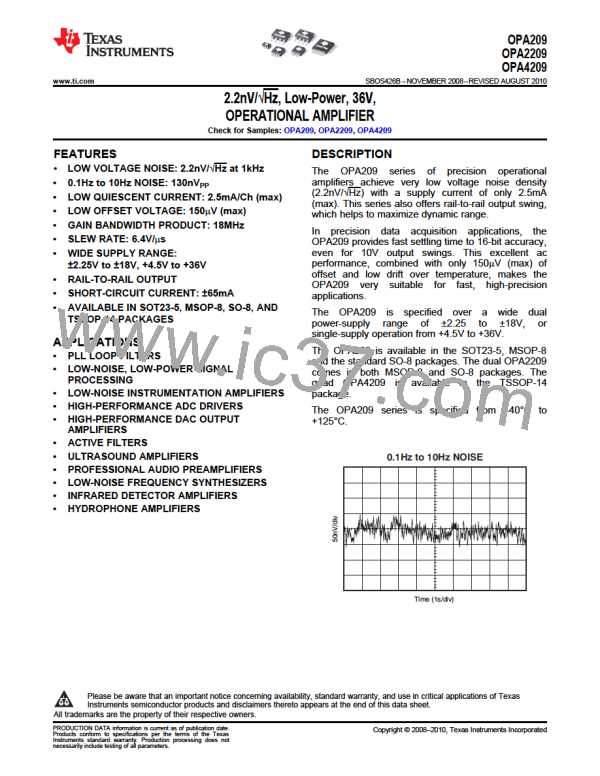OPA209
OPA2209
OPA4209
www.ti.com
SBOS426B –NOVEMBER 2008–REVISED AUGUST 2010
Figure 34 illustrates both noninverting (Figure 34a)
and inverting (Figure 34b) op amp circuit
configurations with gain. In circuit configurations with
gain, the feedback network resistors also contribute
noise. The current noise of the op amp reacts with
the feedback resistors to create additional noise
components.
The feedback resistor values can generally be
chosen to make these noise sources negligible. Note
that low-impedance feedback resistors load the
output of the amplifier. The equations for total noise
are shown for both configurations.
A) Noise in Noninverting Gain Configuration
Noise at the output:
R2
2
2
R2
R1
R2
R1
2
EO
R1
=
1 +
en2 + e12 + e22 + (inR2)2 + eS2 + (inRS)2 1 +
EO
R2
Where eS = Ö4kTRS
´
= thermal noise of RS
1 +
R1
RS
R2
R1
e1 = Ö4kTR1
´
= thermal noise of R1
VS
e2 = Ö4kTR2 = thermal noise of R2
B) Noise in Inverting Gain Configuration
Noise at the output:
R2
2
R2
2
EO
2
=
1 +
en2 + e12 + e22 + (inR2)2 + eS
R1
R1 + RS
EO
RS
R2
Where eS = Ö4kTRS
´
= thermal noise of RS
= thermal noise of R1
R1 + RS
VS
R2
e1 = Ö4kTR1
´
R1 + RS
e2 = Ö4kTR2 = thermal noise of R2
NOTE: For the OPA209 series op amps at 1kHz, en = 2.2nV/√Hz and In = 530fA/√Hz.
Figure 34. Noise Calculation in Gain Configurations
Copyright © 2008–2010, Texas Instruments Incorporated
Submit Documentation Feedback
13
Product Folder Link(s): OPA209 OPA2209 OPA4209

 TI [ TEXAS INSTRUMENTS ]
TI [ TEXAS INSTRUMENTS ]